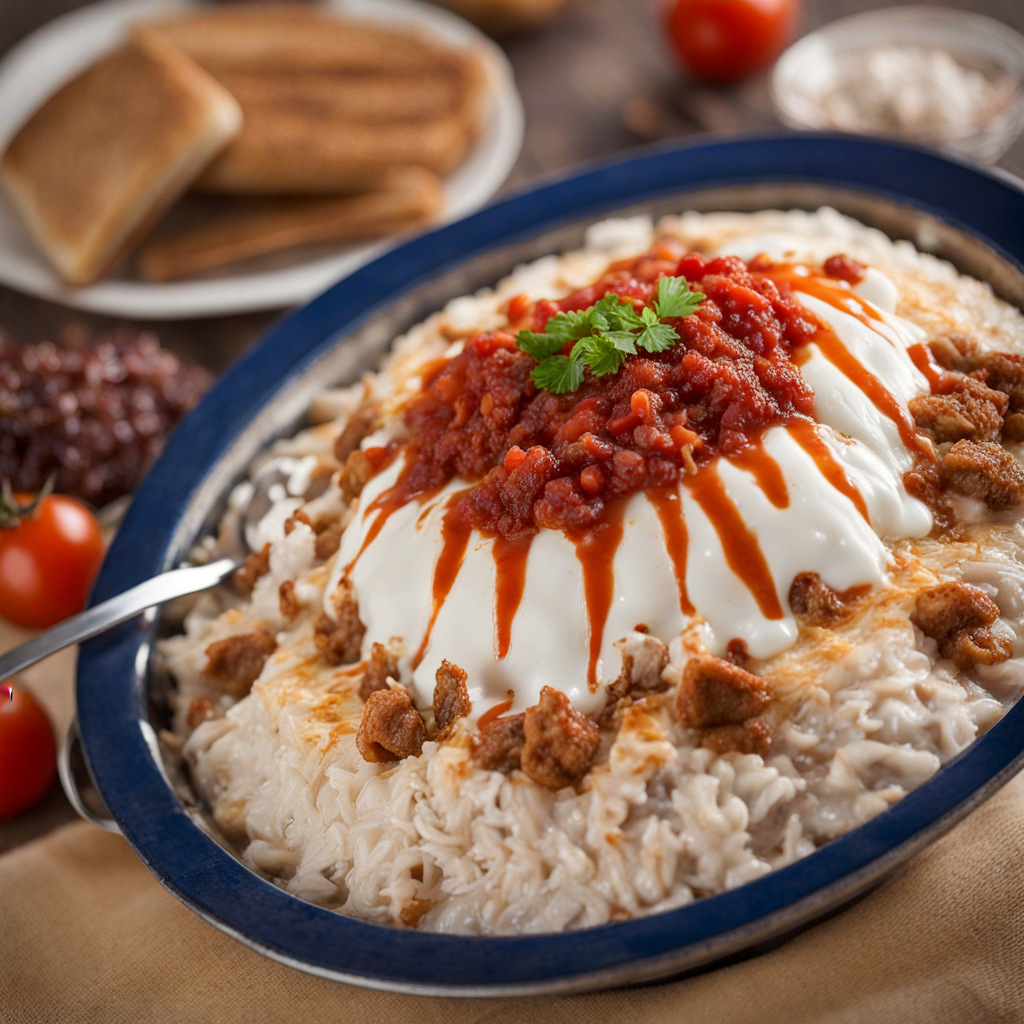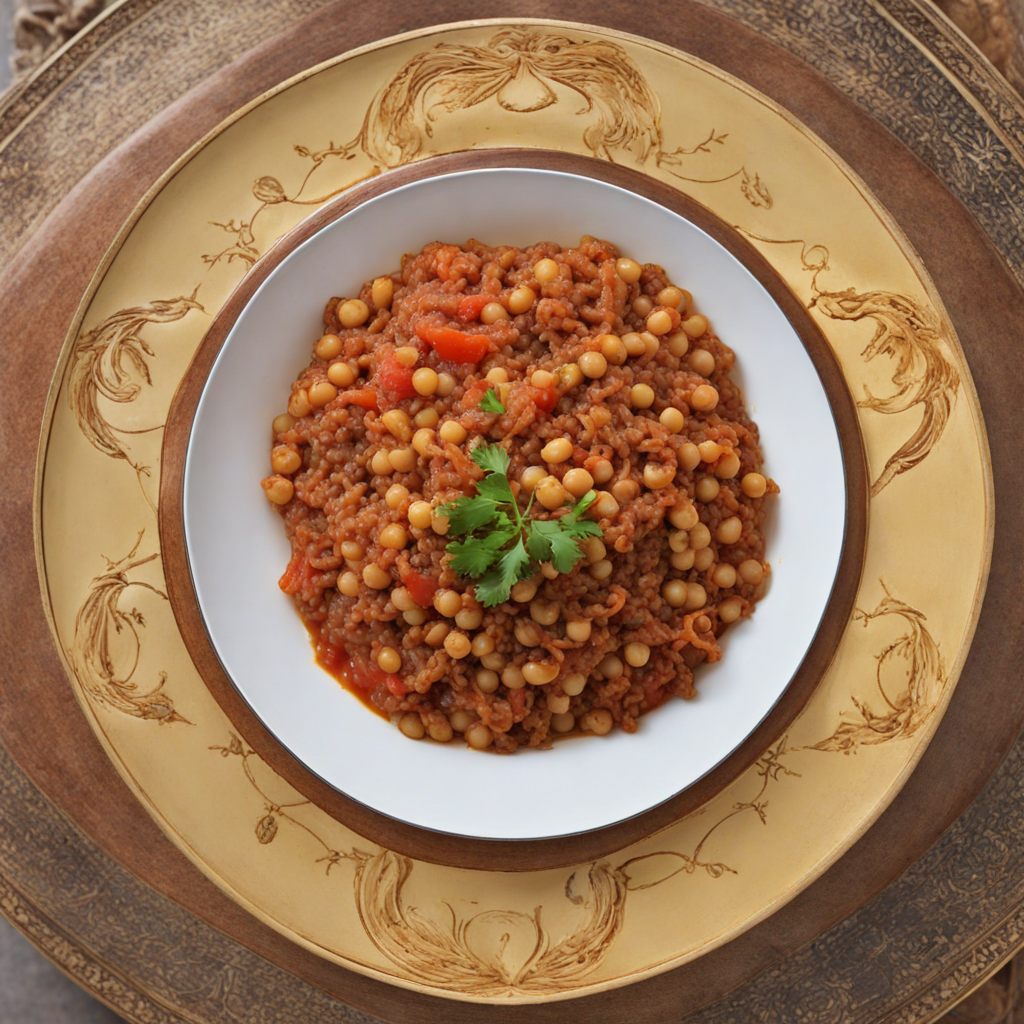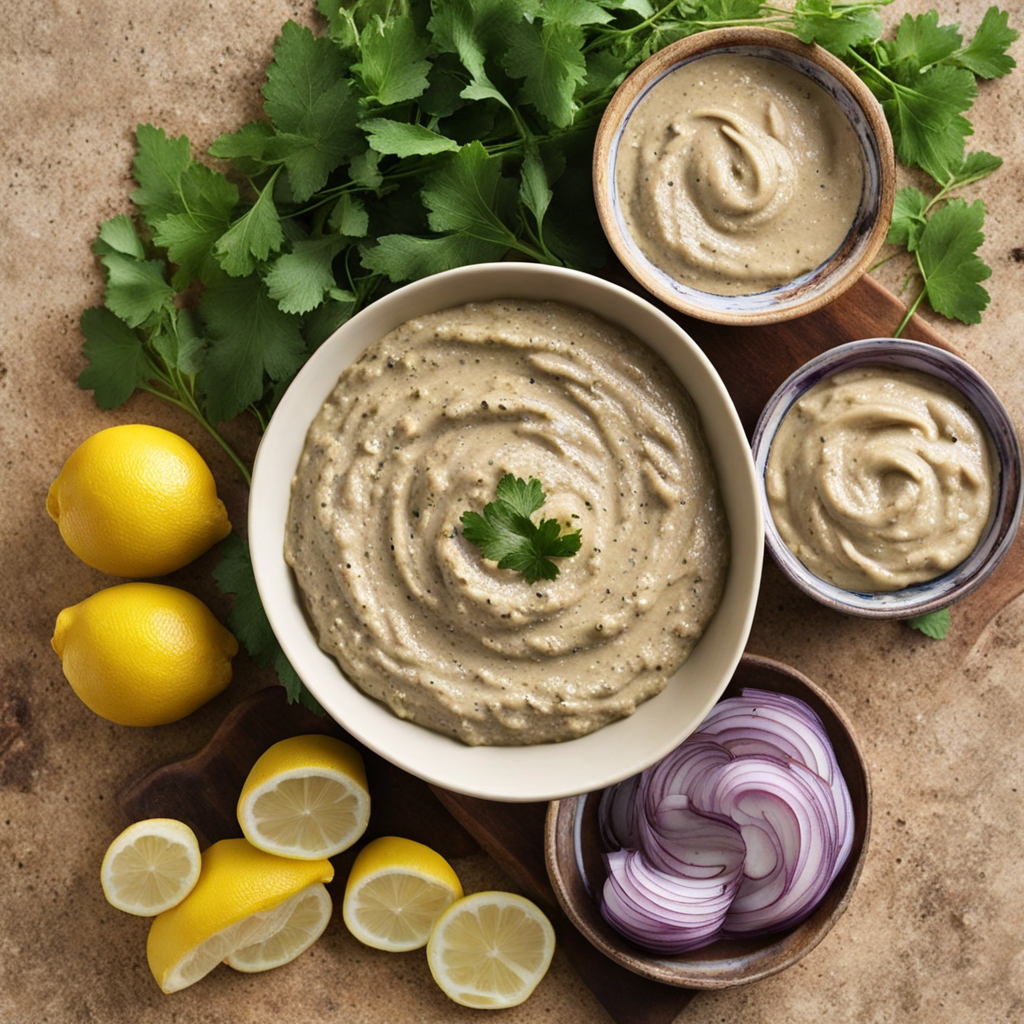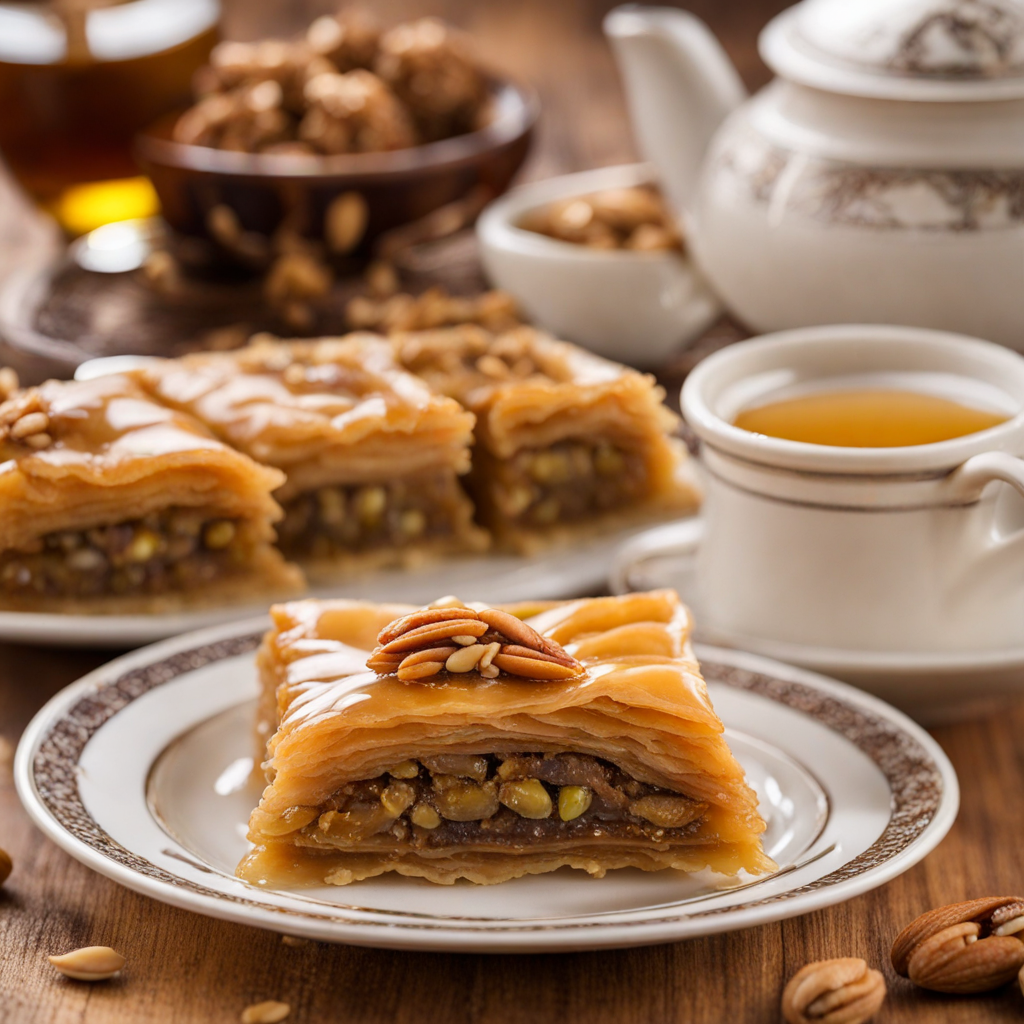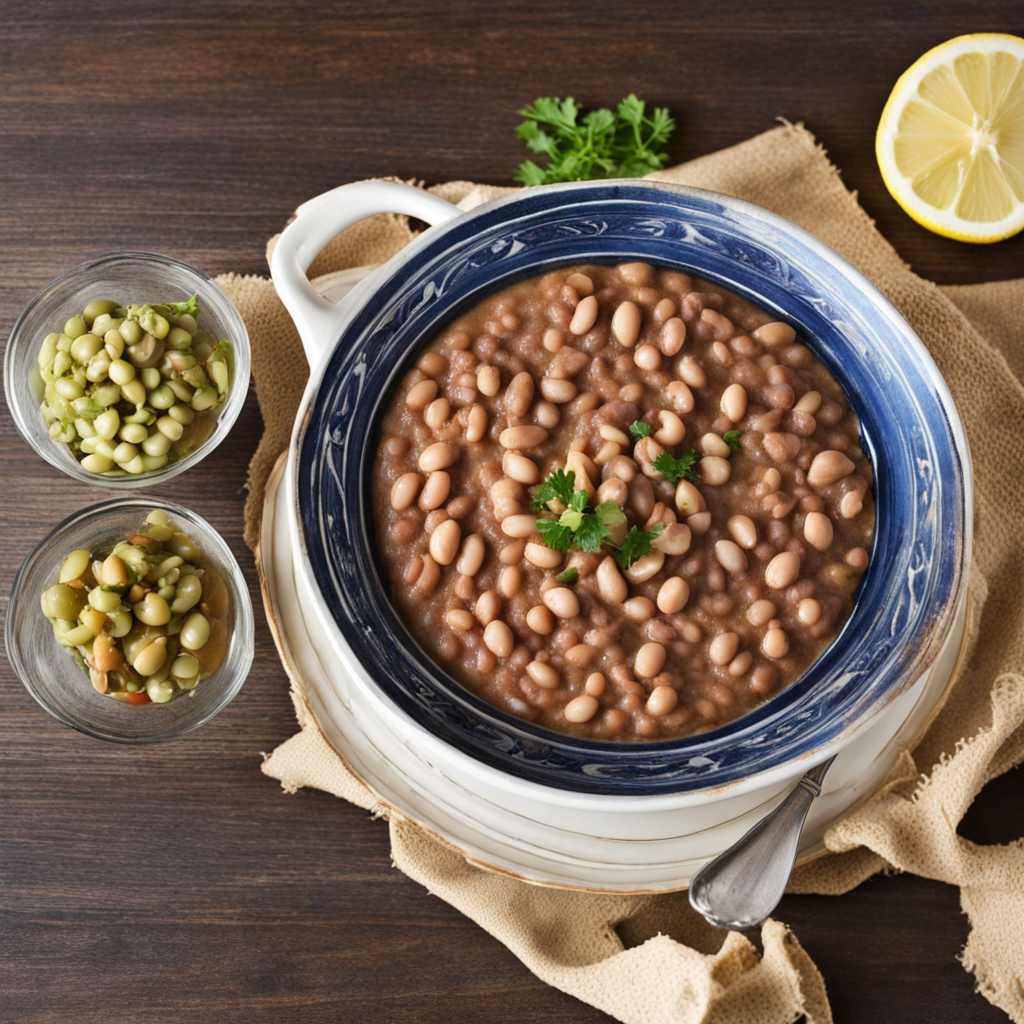Fatteh
Fatteh is a traditional Egyptian dish that beautifully layers textures and flavors, making it a delightful experience for the senses. At its core, Fatteh features a base of crispy, toasted pieces of Arabic bread that provide a satisfying crunch. These golden morsels are then generously topped with a rich, savory mixture of rice, which is often flavored with spices like cumin and garlic, creating a warm and aromatic foundation. The combination of crispy bread and fluffy rice sets the stage for the symphony of flavors that follows. To elevate the dish, Fatteh is typically dressed with a luscious garlic yogurt sauce that adds a creamy and tangy dimension. This sauce often contains a hint of lemon, which brightens the dish and complements the earthy spices. For added depth, a drizzle of warm, spiced chickpeas is included, infusing the dish with protein and a slightly nutty flavor. The chickpeas, often cooked with various spices, not only enhance the taste but also contribute to a heartiness that makes Fatteh a fulfilling meal. Finally, garnishing Fatteh with a sprinkle of toasted pine nuts or slivered almonds adds a delightful crunch and a touch of elegance. Fresh herbs, such as parsley or mint, can also be used to provide a refreshing contrast to the rich components of the dish. The result is a harmonious blend of flavors and textures that showcases the essence of Egyptian cuisine, making Fatteh a must-try for anyone looking to explore new culinary delights.
How It Became This Dish
The Story of فتة (Fattah): A Culinary Legacy of Egypt #### Origins and Early History Fattah, a staple dish in Egyptian cuisine, is a savory delight that embodies the rich tapestry of the nation’s culinary heritage. The word 'فتة' translates to "to crumble" or "to break into pieces," which aptly describes the dish's primary components. Traditionally, Fattah consists of layers of rice, garlic, and vinegar-soaked bread, topped with a hearty meat sauce, often made from lamb or beef. The origins of Fattah can be traced back to ancient Egypt, where bread was a fundamental part of the diet. Archaeological evidence suggests that bread-making techniques date back to around 4,000 BCE. The Egyptians were known to use bread as a base for many dishes, and it was often served with stews and sauces. Over time, the incorporation of rice—introduced to Egypt through trade with Asia—began to reshape the culinary landscape, and thus the foundations for Fattah were laid. #### Cultural Significance Fattah is more than just a meal; it is a dish steeped in cultural significance and tradition. It is often associated with festive occasions, particularly during religious celebrations such as Eid al-Adha and weddings. On these occasions, families gather to prepare and share the dish, symbolizing unity and communal joy. In Egyptian culture, food functions as a medium for storytelling and memory. Fattah, in particular, carries with it tales of family gatherings, the passing down of recipes through generations, and the labor of love involved in its preparation. The dish is often prepared in large quantities, making it ideal for sharing among extended families and friends. Its communal aspect fosters a sense of belonging and connection among those who partake in it. #### Ingredients and Preparation The preparation of Fattah is a labor-intensive process that varies from region to region and family to family. The classic recipe includes three main components: rice, meat, and the all-important fried bread. 1. Rice: The rice used in Fattah is typically basmati, known for its fragrant aroma and fluffy texture. It is cooked separately, often flavored with spices such as cinnamon or cardamom to enhance its taste. 2. Meat: The choice of meat can vary widely, but lamb is the traditional option due to its strong presence in Egyptian cuisine. The meat is usually simmered for several hours with onions, garlic, and a blend of spices, allowing the flavors to meld beautifully. 3. Bread: The bread is a crucial element of Fattah, usually made from a type of Egyptian flatbread called "baladi." It is torn into pieces and lightly fried until golden and crisp before being layered with the other ingredients. 4. Sauce: The final touch is a garlic and vinegar sauce, sometimes enriched with tomato, that is poured over the assembled dish, adding a tangy flavor that balances the richness of the meat and the heartiness of the rice. The assembly of Fattah is an art form in itself. Traditionally, it is served in a large dish, with layers of bread at the bottom, followed by rice, and topped with the meat and sauce. This layered presentation creates an inviting feast, perfect for communal dining. #### Evolution Through Time As Egypt underwent various cultural and political changes, so too did Fattah. During the Islamic Golden Age (8th to 13th centuries), the influence of Arab cuisine expanded, introducing new spices and cooking techniques. This era saw the introduction of intricate flavors and presentation styles that would further enrich Fattah. The Ottoman Empire’s rule over Egypt from the 16th to the 18th centuries also left a mark on the dish. Turkish culinary practices began to influence local cooking, leading to variations of Fattah that incorporated different meats, such as chicken and even fish, along with diverse spices that reflected the broader Ottoman palate. By the 20th century, Fattah had become a national dish, featured in homes and restaurants alike. It became symbolic of Egyptian identity, particularly during times of social change and political upheaval. The dish was embraced by various socio-economic classes, a testament to its versatility and adaptability. #### Modern-Day Fattah Today, Fattah remains a beloved dish in Egypt, enjoyed by people from all walks of life. While the traditional recipe continues to be cherished, modern interpretations have emerged, reflecting contemporary tastes and dietary preferences. Some chefs experiment with vegetarian versions, replacing meat with lentils or chickpeas while maintaining the essential components of rice and bread. Moreover, Fattah has gained international recognition, with Egyptian restaurants around the world serving their unique takes on the dish. The global diaspora has helped spread appreciation for this culinary treasure, ensuring that its flavors and traditions endure. #### Conclusion Fattah is more than just a dish; it is a reflection of Egypt's history, culture, and communal values. Its evolution from ancient times to the present encapsulates the dynamic nature of Egyptian cuisine, characterized by its ability to adapt and incorporate influences while remaining deeply rooted in tradition. As families continue to gather around the table to enjoy this exquisite dish, they not only savor its delightful flavors but also engage in the timeless practice of storytelling, bonding, and celebrating their heritage. In this way, Fattah serves as a delicious reminder of Egypt’s rich culinary narrative, a dish that is both a feast for the senses and a symbol of connection across generations.
You may like
Discover local flavors from Egypt


